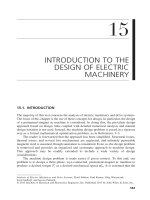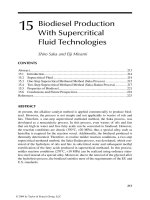Lecture BSc Multimedia - Chapter 15: Content-based retrieval
Bạn đang xem bản rút gọn của tài liệu. Xem và tải ngay bản đầy đủ của tài liệu tại đây (15.41 MB, 65 trang )
CM3106 Chapter 15: Content-Based
Retrieval
Prof David Marshall
and
Dr Kirill Sidorov
www.facebook.com/kirill.sidorov
School of Computer Science & Informatics
Cardiff University, UK
Motivation
Suppose we want to search a multimedia database.
Applications:
Medicine: find similar diagnostic images.
Crime: find person according to mugshot, fingerprints,
sketch, or verbal description.
Art: search museum collection of paintings.
Copyright: who used my images without permission?
Retail: find shoes similar to these ones, only red.
CM3106 Chapter 15: CBR
Image Retrieval
1
Traditional Techniques
Text-based multimedia search and retrieval:
Annotations (metadata).
File names. Keywords. Captions. Surrounding text.
Photography conditions. Geo tags. Creation date.
Verbal portrait in the police database.
Usually does a very good job provided the annotations are
accurate and detailed.
E.g. google image search, youtube video search.
Disadvantages:
Manual annotation requires vast amount of labour.
Different people may perceive the contents of images
differently: no objectivity in keywords/annotations.
CM3106 Chapter 15: CBR
Image Retrieval
2
Traditional Techniques
CM3106 Chapter 15: CBR
Image Retrieval
3
Traditional Techniques
Describe in words what is happening in this image!
CM3106 Chapter 15: CBR
Image Retrieval
4
How do Humans Compare Images?
CM3106 Chapter 15: CBR
Image Retrieval
5
How do Humans Compare Images?
CM3106 Chapter 15: CBR
Image Retrieval
6
How do Humans Compare Images?
CM3106 Chapter 15: CBR
Image Retrieval
7
How do Humans Compare Images?
CM3106 Chapter 15: CBR
Image Retrieval
8
Content-based Image Retrieval
Low-level: based on color, texture, shape features.
Find all images similar to given query image.
Search by sketch.
Search by features e.g. “find all green images with
texture of leaves”.
Check whether image is used without permissions.
Images are compared based on low-level features, no
semantic analysis involved.
A lot of research since 1990’s. Feasible task.
Mid-level: semantics come into play
E.g. “find images of tigers”.
Very active and challenging research area.
High-level:
E.g. “find image of a triumphant woman”.
Requires very complex logic.
Far from being available at present level of technology.
CM3106 Chapter 15: CBR
Image Retrieval
9
Image Retrieval
CM3106 Chapter 15: CBR
Image Retrieval
10
CBIR Framework Example
CM3106 Chapter 15: CBR
Image Retrieval
11
Naive Per-pixel Comparison
Pixels are the most privitive features, so. . .
Compare images on a per-pixel basis.
Feature vector: raw array of pixel intensities.
dc (I(r, c), Q(r, c)).
D(I, Q) =
r
c
Bad Idea!
Why?q
CM3106 Chapter 15: CBR
Image Retrieval
12
Image/Audio Fingerprints
A fingerprint is a content-based compact signature that
summarises some specific audio/video content.
Requirements:
Discriminating power.
Ability to accurately identify an item within a huge
number of other items (e.g. large audio collection in
Shazam, millions of songs).
Low probability of false positives.
Query potentially has low information content: a few
seconds of audio, a crude sketch of an image.
CM3106 Chapter 15: CBR
Image Retrieval
13
Image/Audio Fingerprints
Invariance to distortions.
Shazam audio query may be distorted and superimposed
with other audio sources.
Background noise.
Transformations: image rotation/scale/translation,
warping. Lighting variations. Audio may be played faster
or slower.
Compression artifacts
Cropping, framing.
Compactness.
Making indexing feasible.
Allowing for fast search.
Computational simplicity.
E.g. for use on mobile devices.
CM3106 Chapter 15: CBR
Image Retrieval
14
Feature Extraction in Images
Object identification, e.g.
Detect faces (realatively robust these days).
Segmentation into blobs.
Text detection/OCR.
General case is difficult.
Colour statistics, e.g. histogram (3-dimensional array
that counts pixels with specific RGB or HSV values in an
image.)
Colour layout, e.g. “blue on top, green below”.
Texture properties, usually based on edges in image.
Motion information (in videos).
CM3106 Chapter 15: CBR
Image Retrieval
15
Search by Colour Histogram
Search by colour histogram of sunset
(scores shown under images).
CM3106 Chapter 15: CBR
Image Retrieval
16
Histogram Comparison
For each i-th training image generate colour histogram
Hd .
Normalise it so that is sums to one (to reduce the effect
of the size of image).
Store it as the feature in the database.
For a query image, also compute histogram Hq .
CM3106 Chapter 15: CBR
Image Retrieval
17
Histogram Comparison
Compare against the database using histogram
intersection:
min(Hid , Hiq ).
Intersection =
i
For similar histograms (images) the intersection is closer to 1.
Another standard measure of similarity for color
histograms:
Difference = (Hd − Hq )T A(Hd − Hq ),
where A is a similarity matrix.
Or simply L1 norm:
Difference =
CM3106 Chapter 15: CBR
Image Retrieval
|Hid − Hiq |.
18
Search by Colour Histogram
CM3106 Chapter 15: CBR
Image Retrieval
19
Search by Colour Histogram
CM3106 Chapter 15: CBR
Image Retrieval
20
Search by Colour Layout
An improvement over basic colour/histogram search.
The user can set up a scheme of how colors should
appear in the image, in terms of coarse blocks of colour,
e.g. on a grid.
The training images are partitioned into regions and
histograms (or simply average colours) are computed for
each region.
Matching process is similar.
CM3106 Chapter 15: CBR
Image Retrieval
21
Search by Colour Layout
Retrieval by “color layout” in IBM’s QBIC system.
CM3106 Chapter 15: CBR
Image Retrieval
22
Colour Signatures and EMD
For each image, compute color signature:
Define distance between two color signatures to be the
minimum amount of “work” needed to transform one
signature into another (earth mover’s distance):
CM3106 Chapter 15: CBR
Image Retrieval
23
Colour Signatures and EMD
Transform pixel colors into CIE-LAB color space.
Each pixel of the image constitutes a point in this color
space.
Cluster the pixels in color space. (Clusters constrained to
not exceed R units in L,a,b axes.)
Find centroids of each cluster.
Each cluster contributes a pair (µ, w) to the signature.
µ is the average color.
w is the fraction of pixels in that cluster.
Typically there are 8 to 12 clusters.
CM3106 Chapter 15: CBR
Image Retrieval
24









